16 Sensory Haircut Solutions for Kids, Adults, Autism & Barbers
16 Sensory Haircut Solutions for Kids, Adults, Autism & Barbers
Sensory haircuts can be a challenging experience for both children and adults with sensory processing issues. The sensory overload associated with haircuts can lead to meltdowns, sensory aversion, and anxiety.
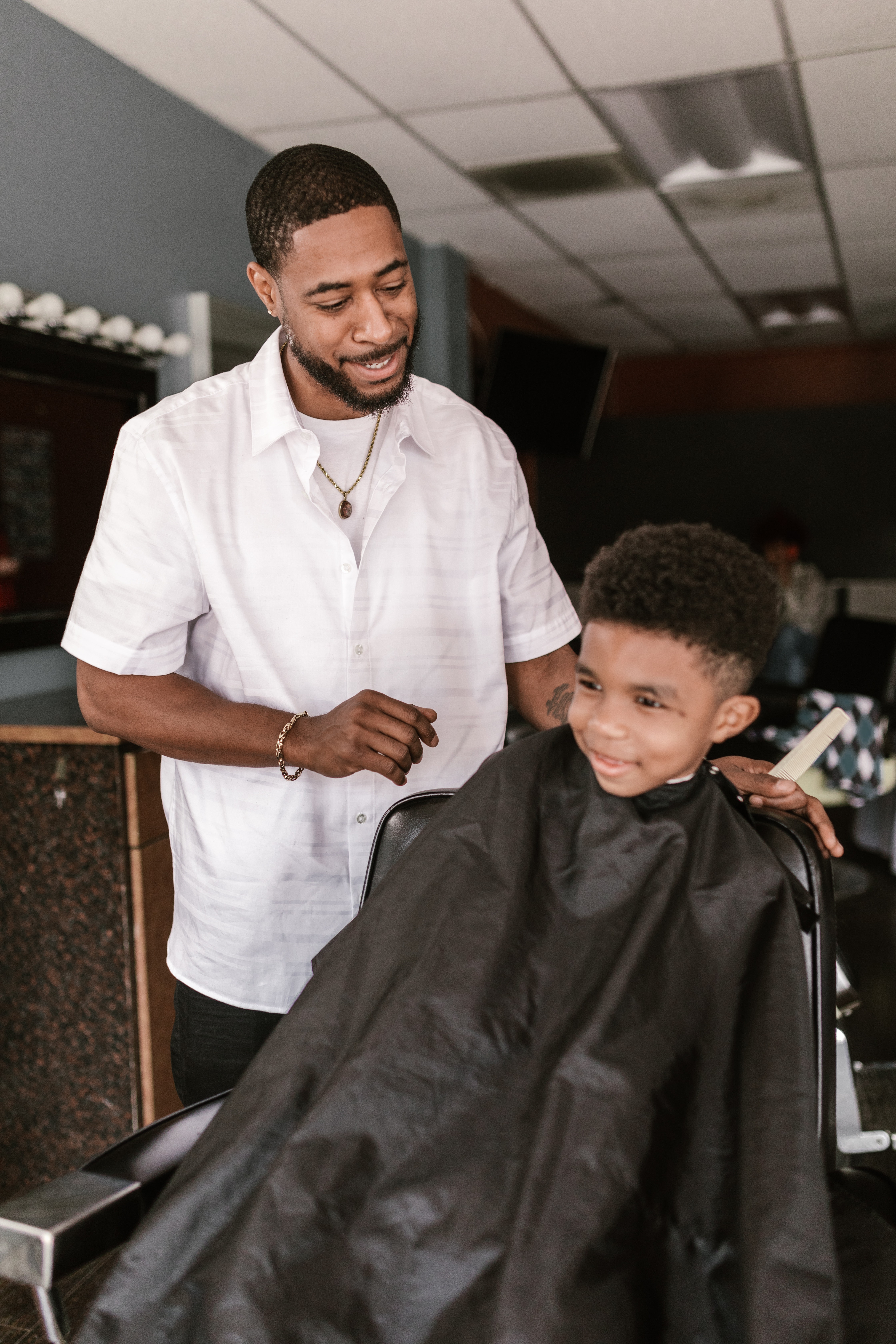
Here are 16 sensory haircut solutions barbers can implement that can help make the experience more comfortable for both kids and adults.
Sensory Haircut Solutions
In this article –
- Sensory Haircut Solutions for Adults, Kids, Toddlers, & Autism
- What is a Sensory Friendly Haircut?
- 4 Sensory Processing Issues Can Get in the Way of Haircuts
- How can I Help my Child with Sensory Issue Haircuts?
- How do I Get my Autistic Child to Sit for a Haircut?
- 6 Sensory Haircut Solutions a Barber Should Implement
- What is the Best Haircut for Sensory Issues
- FAQs for Sensory Haircut Solutions for Kids, Adults & Barbers
- Summary
Sensory Haircut Solutions for Adults, Kids, Toddlers, & Autism
Tips for a Sensory-Friendly Experience
Sensory processing disorders can often make haircuts a challenging and overwhelming experience for both children and adults. Whether you are dealing with a toddler, an adult, or someone with autism, these solutions can help ensure a more comfortable and successful haircut experience.
6 Sensory Haircut Solutions for Toddlers
- Allow them to watch first – Show them pictures or videos of the haircut process, explain what to expect during the haircut, and discuss the sensory experiences they are likely to encounter, such as the feel of the scissors or the sound of the clippers. If possible, have them watch you get your haircut before theirs.
- Sensory-friendly tools – Utilize sensory-friendly tools such as vibrating clippers, scissors with a soft grip handle, or brushes with soft bristles. These tools can help minimize sensory discomfort and ensure a more pleasant haircut experience. Talk to your hairstylist beforehand to see if they would be comfortable allowing your toddler feel their tools before using them on the child.
- Visual distractions – Keeping toddlers focused on something other than the haircut can be beneficial. Provide visual distractions such as books, toys, or I’ve even put sticky notes on the mirror for them to look at. Parents have played hide and seek in the mirror with the child before to help redirect their attention and reduce anxiety during the haircut.
- Break it down – If your toddler struggles with sitting for an extended period, break the haircut into smaller sections. Trim a little bit at a time, taking short breaks in between. This allows them to regroup and prevents overwhelming sensory input. You can even ask the stylist to just start with what you feel are the most important parts of the haircut, such as getting the hair out of the eyes or off of the neck or ears. Then if the child can stay in the chair longer, then extend the haircut further.
- Give your toddler choices – “Do you want to sit on my lap or by yourself?” Or, “Would you like to wear this cape or that cape?” This will help the child feel as though they have more control over the situation and gives them an opportunity to share what they are comfortable with in the moment.
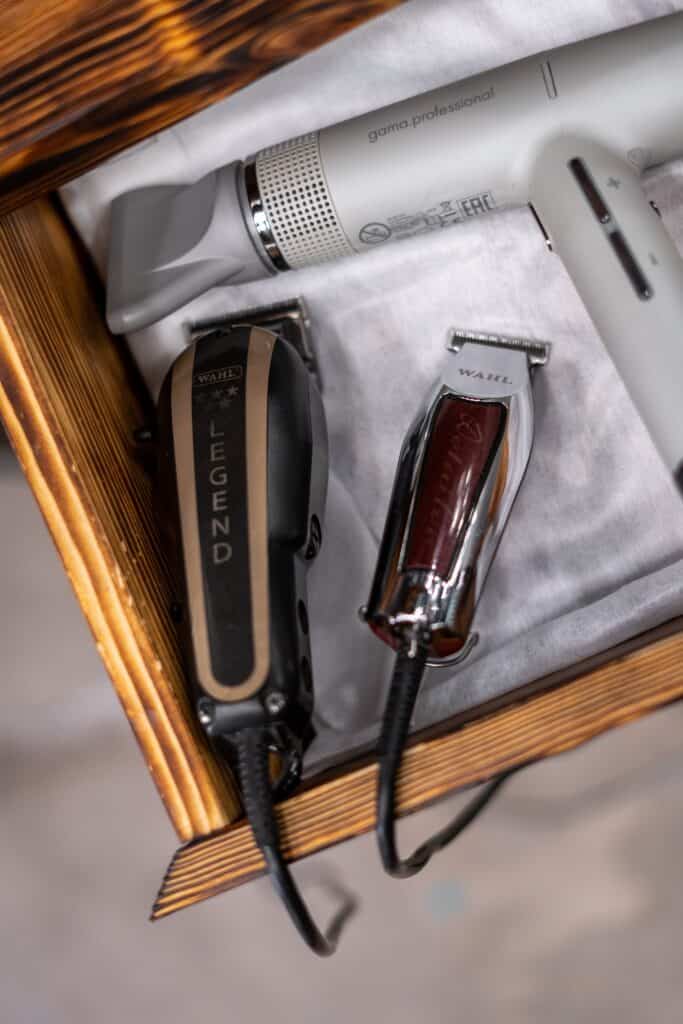
3 Sensory Haircut Solutions for Adults
Barbers, pay attention to your client’s cues! Just because they’re adults doesn’t mean they might not be sensitive to the sensations of a haircut. Here are a few things to do if you notice that your client is sensitive.
- Communication is key – Communicate openly and effectively with the adult client before the haircut. Ask about any sensory sensitivities or preferences they may have. By understanding their needs, you can tailor the haircut experience accordingly.
- Offer sensory breaks – Allow adults to take sensory breaks throughout the haircut if needed. This can involve stepping away from the chair, exploring sensory tools, or practicing deep breathing exercises. Providing these breaks can help them regulate their sensory input and maintain a calm state.
- Adjust lighting and noise levels – Create a soothing environment by adjusting the lighting and noise levels in the salon. Speak softly, dim the lights and put on softer background music to help reduce sensory overload and promote relaxation.
Sensory Haircut Solutions for Autism
Caregivers, it is helpful for the staff of the salon to know ahead of time if there are special needs to prepare for in advance before the time of arrival, such as a change of music or to ask if there is a stylist that has experience and an understanding of their client’s needs for the haircut.
As a barber I can assure you that there is nothing offensive about asking the barber to make some extra efforts to make the haircut experience smoother for everyone involved. (The only thing offensive to a barber is if you tell them how to do their job, like how to cut the hair. That’s different than telling them what haircut you’d like.)
Also, finding a hairstylist with an at-home studio or that does home visits can be helpful if going to a salon is too overwhelming for an autistic person.
Barbers, we don’t always get a heads up when it comes to clients with autism or other severe sensory processing disorders, but if you do get the heads up, here are a couple of things to help you prepare the shop for in advance to offer a sensory friendly haircut experience for your client.
- Gradual exposure – For individuals with autism, sensory challenges can be overwhelming. Gradual exposure to the haircut environment is crucial. Start with short visits to the salon to familiarize them with the surroundings, tools, and stylists. It is essential to build trust and comfort over time.
- Sensory-friendly waiting area – Designate a sensory-friendly waiting area in the salon. Fill it with calming activities such as fidget toys, weighted blankets, or visual timers. This area provides a safe space for individuals with autism to acclimate themselves before their haircut.
- A separate place for the haircut – If the salon happens to have booths or a quieter area where you can cut hair, that is an excellent solution for clients that are easily overwhelmed by extra noise and other busy salon noises.
- Bring a weighted vest or weighted blanket – Sometimes a weighted blanket or vest can help calm the overwhelmed senses and make the experience more pleasant.

What are Two Major Triggers of Sensory Processing Disorders during Haircuts?
- Tactile sensitivity – Many individuals with sensory processing disorders experience hypersensitivity to touch. The sensations of hair clippings falling on their skin, the cape touching their neck, or the comb running through their hair can be incredibly discomforting. Using softer materials, providing a lightweight cape, or using a neck brush instead of a comb can help reduce tactile sensitivity triggers.
- Auditory sensitivity – The noise levels in salons can be overwhelming for individuals with auditory sensitivity. The sound of clippers, blow dryers, or even chatter in the background can cause distress. Using noise-canceling headphones, providing a quieter space, or using quieter tools can help minimize auditory triggers.
By implementing these sensory haircut solutions, you can create a more inclusive and accommodating salon environment for individuals with sensory processing disorders, ensuring a positive and stress-free experience for all.
What is a Sensory Friendly Haircut?
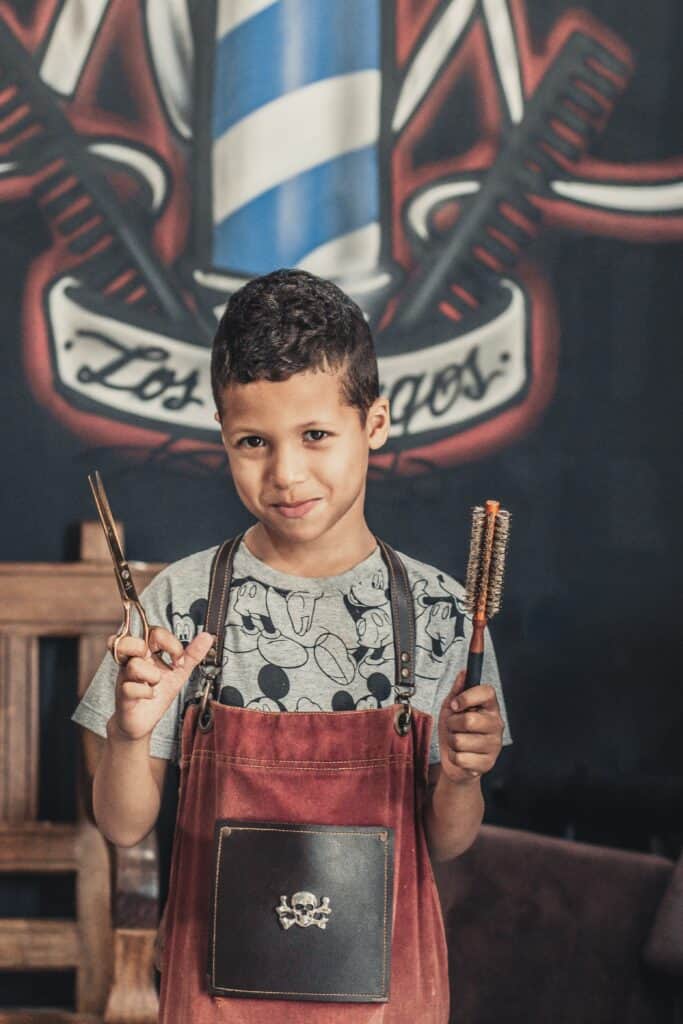
A sensory friendly haircut is a haircut specifically tailored to meet the needs of individuals with sensory processing issues. Which is becoming more and more common and can appear in countless different ways.
It takes into account the individual’s unique sensory preferences and aversions to create a more comfortable and tolerable haircutting experience.
4 Sensory Processing Issues Can Get in the Way of Haircuts?
There are several sensory processing issues that can make haircuts difficult for individuals. Some of these can look like –

- Sensory sensitivity – Some individuals may have heightened sensitivity to certain sensations such as touch, sound, or visual stimuli. These sensitivities can make the experience of a haircut overwhelming and uncomfortable.
- Sensory aversion – Certain individuals may have specific aversions to certain sensory experiences, such as the sound of clippers or the feeling of hair falling on their skin. These aversions can cause a negative reaction during a haircut.
- Sensory seeking – On the other hand, some individuals may seek out certain sensory experiences. For example, they may enjoy the feeling of vibration from clipper blades or the sound of scissors cutting through hair. These seeking behaviors can become disruptive during a haircut. (Though I’ve never experienced this in any kind of an uncomfortable way in my 10+ years behind the chair.)
- Anxiety – The anticipation and unfamiliarity of a haircut can cause anxiety for individuals with sensory issues. This anxiety can further exacerbate sensory sensitivities or aversions, making the experience even more challenging.
15 Tips for Overcoming Bad Haircut Anxiety
How do I Help My Child with Sensory Issue Haircuts?
If your child has sensory processing issues, there are several strategies you can use to incorporate into sensory haircut solutions.

- Prepare in advance – Before the haircut, prepare your child by talking to them about what to expect. Show them pictures or videos of a haircut so they can visualize the process. Familiarity can help reduce anxiety.
- Practice at home – Practice giving your child mini haircuts at home using child-safe scissors or clippers. This can help them become more comfortable with the sensations and sounds associated with a haircut.
- Use visual supports – Visual supports, such as a visual schedule or a social story, can help your child understand the steps involved in a haircut. This visual structure can provide reassurance and reduce anxiety.
- Provide deep pressure input – Deep pressure input can help regulate the sensory system and provide a calming effect. Before and during the haircut, use tools such as a weighted blanket, lap pad, or a firm hug to provide deep pressure input to your child.
- Use distraction techniques – Distract your child during the haircut by engaging them in a preferred activity such as, listening to music, or playing with a sensory toy like a fidget spinner or a slinky. This can help divert their attention away from the discomfort of the haircut.
The Slinky Trick
I actually keep a slinky in my station so that whenever any kid comes in and they have a hard time sitting still they have something they can touch and feel under the cape that continually changes shape.
The slinky toy trick I learned from a small autistic client’s occupational therapist that would attend haircuts with them and I have implemented it into my other kid’s haircuts and have yet to have it fail. No kid, autistic, or other sensory processing issues have ever turned down the slinky or it failed to do the trick for just long enough to pull off an acceptable fast haircut for the kiddo.
I am always sure to make the child feel comfortable and safe with me and the tools before touching them to their head or body to prevent panics.

How do I Get My Autistic Child to Sit for a Haircut?
Getting an autistic child to sit still for a haircut can be a challenge due to sensory sensitivities and repetitive behaviors. Here are 5 strategies that can help-
- Gradual desensitization – Gradually expose your child to the sensations and sounds associated with a haircut. Start by introducing them to the tools used in a haircut, such as scissors or clippers, in a non-threatening way. Over time, gradually increase the exposure until your child is comfortable enough to sit for a full haircut.
- Use visual supports – Visual supports can help your child understand the expectations during a haircut. Use a visual schedule or a social story to visually represent the steps involved in a haircut, and ask the stylist to help describe what they are doing while the haircut is happening if you think your child can handle the sound of a stranger’s voice on top of the new sensations. This can provide predictability and reduce anxiety.
- Offer choices – Give your child choices during the haircut, such as selecting the type of cape they want to wear or the order in which their hair is cut (or whether they want to wear a cape at all). Or ask if the stylist is comfortable giving the child the option to sit on the booster, on your lap, on the floor, or even stand during the haircut. Offering choices can give them a sense of control and empower them during the haircut.
- Incorporate special interests – Incorporate your child’s special interests into the haircut experience. For example, if your child is interested in cars, bring a toy car for them to hold during the haircut. This can help redirect their attention and make the experience more enjoyable.
- Grab a sensory toy – Sensory toys such as fidget spinners, slinkies (my favorite), anything with buttons… can help keep the hands busy while the stylist is cutting the hair.
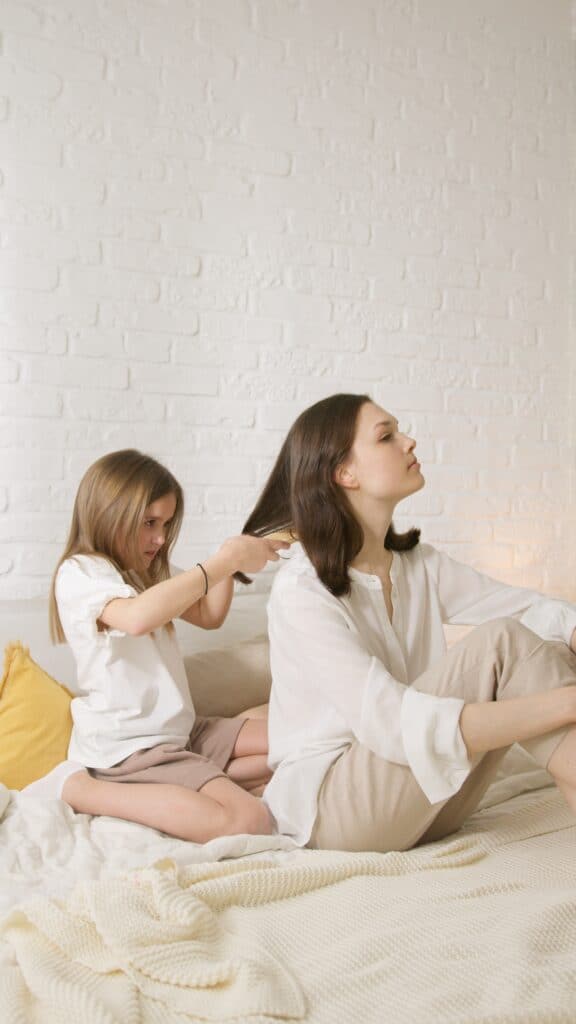
6 Sensory Haircut Solutions a Barber Should Implement
These 6 tips are excellent for barbers to do differently to help accommodate their clients with sensory processing sensitivities.
Barbers can play a key role in providing sensory haircut solutions. Here are some strategies to create a more sensory-friendly environment –
- Dim the lights – Bright lights can be overwhelming for individuals with sensory sensitivities. Dimming the lights in the salon can help create a more calming environment.
- Use soft, comfortable capes – Choose capes that are made of soft, non-irritating material. Avoid capes with tight or itchy elastics that can cause discomfort for individuals with sensory sensitivities. Even let the client choose which cape they prefer (especially kids) or even whether they want a cape at all (small children)
- Provide ear protection – Offer ear protection, such as ear defenders or headphones, to reduce the noise of clippers and other salon sounds. This can help individuals with sensory sensitivities feel more comfortable during the haircut.
- Offer a counter-sensory item – Offering a client a counter-sensory item such as a weighted lap pad or blanket, or toy like a slinkky, can benefit individuals who respond well to deep pressure input. The added weight of a blanket can help promote relaxation and reduce anxiety during the haircut.
- Communicate with the client – Prior to the haircut, ask the client about their sensory preferences and aversions. Be open to making modifications to accommodate their needs and provide a more comfortable experience. For children, you can even number the steps of the haircut so they know how many more are left, such as (we’re all done with the sides, we have two more to go when we blend and cut the top. You’re doing great!)
- Give Positive Feedback – Everyone responds well to compliments and positive feedback. To tell a child that they’re being brave. Or encourage adults with other sensitivities (an adult with a sensitive neck who can’t help but scrunch during the haircut) that you’re almost there or you’re halfway done and they’re doing great (but not in a demeaning tone, of course, that’s unnecessary and unkind.)
What is the Best Haircut for Sensory Issues?
The best haircut for individuals with sensory issues is one that takes into account their unique sensory needs and preferences. Some haircut styles that are often well-tolerated by individuals with sensory issues might be –
- Short haircuts – Short haircuts can be more comfortable for individuals who are sensitive to the feeling of hair on their skin. They also require less maintenance and reduce the frequency of haircuts.
- Layered haircuts – Layered haircuts can provide a softer, less uniform texture that may be more tolerable for individuals with sensory sensitivities. These haircuts also allow for more movement and reduce the feeling of heaviness on the scalp.
- Gradual haircuts – Gradual haircuts involve cutting the hair gradually over a few sessions. This allows individuals with sensory sensitivities to gradually acclimate to the sensations and sounds of a haircut.
- Tapered haircuts – Tapered haircuts involve gradually reducing the length of the hair towards the nape of the neck. This can provide a more gradual transition from longer to shorter hair, reducing the shock of a sudden haircut.
- Scissor Cuts – A shear-only haircut can be helpful for some individuals that can’t handle the noise and vibration of the clippers.
FAQs for 16 Sensory Haircut Solutions – Kids, Adults, & Barbers – From a Barber
What are Calming Clippers?
Calming clippers are specially designed clippers that are quieter and offer a more gentle cutting experience. These clippers produce less noise and vibration, which can be overwhelming for individuals with sensory sensitivities.
Calming clippers often feature a low-noise motor, ergonomic design, and adjustable cutting settings. They are designed to reduce the sensory discomfort associated with traditional clippers, making the haircut experience more tolerable for individuals with sensory processing issues.
Barbers and hairstylists can invest in calming clippers to offer a more sensory-friendly haircut experience. However, it’s important to note that not all individuals with sensory issues will benefit from calming clippers. It’s essential to understand each individual’s unique sensory preferences and aversions before introducing any new technology or equipment.
Should a Child be Allowed to Refuse a Haircut?
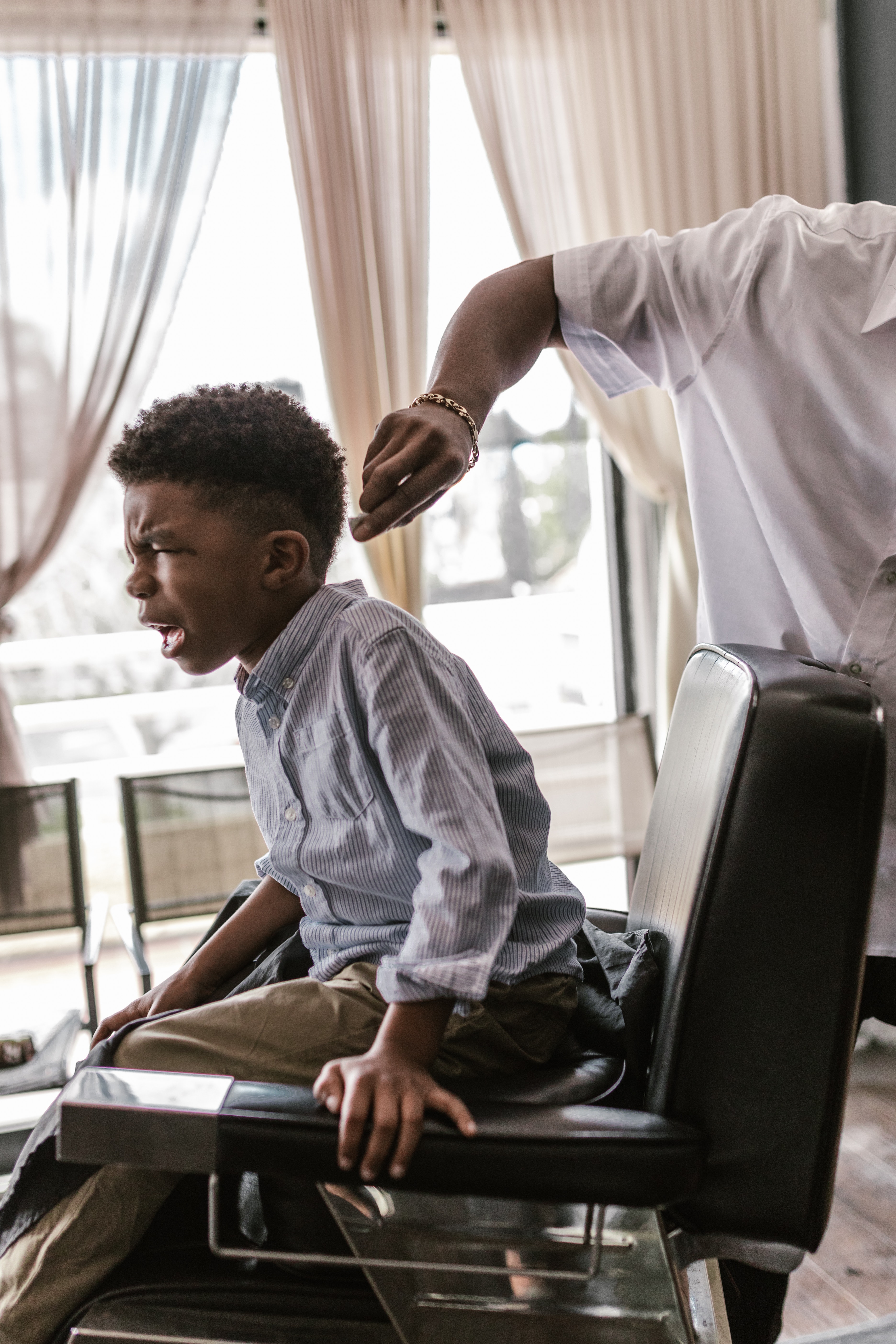
Absolutely.
Sometimes a small child will find a haircut scary. A stranger is touching them, breaking the personal bubble, with tools that give strange sensations on their head (a comb pulling their hair and clippers vibrating against their skull) and they’re told to sit still.
It can take a while for a child to get used to the idea and be comfortable sitting for a haircut.
A good barber takes the time to earn the child’s trust. For example, showing them the tools, allowing them to feel them with their fingers or even ‘using’ the tools (brushing my hair, their hair, or the parent’s hair with the comb, I’ve even let some kids ‘cut my hair’ by using trimmers on my arm and shaving my arms down, it makes them feel like they have more control and understanding of what’s going on). Feeling the clippers with their hands and on their shoulder or neck before on their head. Or sit on mom’s lap or even on the floor (or standing even) if that’s where they’re comfortable. A good stylist or barber will meet the child where they’re at and earn the child’s trust before forcing them to get their hair cut.
The further we get down the line and the more studies come out we are just realizing how common sensory sensitivities are and haircuts are one of the first things doctors ask about if a child is being tested for sensory disorders. It can be overwhelming and scary.
Now, there comes a time when they must get a haircut and can no longer refuse (like 8–10 years old) and can still make some of their own ground rules such as feeling the clippers first but it becomes a show if they say they won’t get a haircut because they don’t want to.
There’s a limit. But please, don’t force your small kids to be okay with haircuts if they haven’t had them before.
Can an Autistic Person Get a Haircut?
Yes, absolutely. Sometimes it’s a slower process, or maybe even faster, but it depends on the individual.
👏 Communication with the client,
👏 Advocating and affirming their needs,
👏 Adjusting according to what they need is absolutely necessary.
Do not force an autistic person to get a haircut if they’re not ready. It can take practice, even a few practice visits to get used to the sounds and even the way the tools feel in their hands or on their body (gently combing their hand for example).

Hair Consultation Questions – How to Conduct the Perfect Hair Consultation
Hairdresser Tip Chart – How Much to Tip to be a Good Customer
How to Make Homemade Conditioner for Hair – 21 Ingredients Found in Your Kitchen
